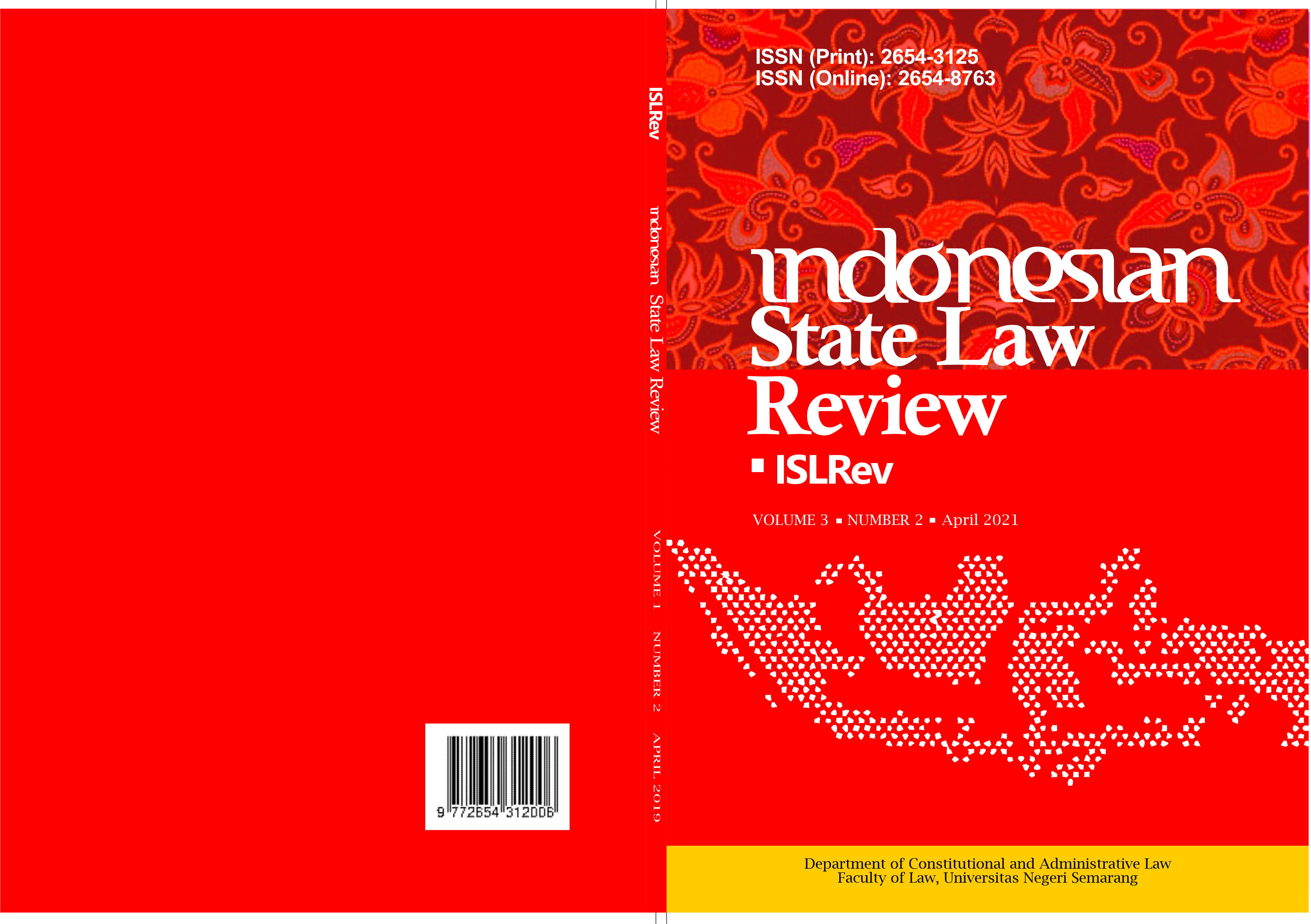TANGGUNG JAWAB HUKUM TERHADAP KERUSAKAN LINGKUNGAN DALAM KASUS LUMPUR LAPINDO MENURUT UNDANG-UNDANG NOMOR 11 TAHUN 2020 (UU CIPTAKER)
Main Article Content
Abstract
The narrative about the establishment of Law No. 11 of 2020 has been realized through the ratification of The Job Creation Act on November 2, 2020 by President Jokowidodo. The establishment of The Job Creation Act aims to harmonize legislation that has been considered to hinder the investment and development climate. The number of related legislation causes hipper-regulation regulations so it may be ineffective. The existence of The Job Creation Act combines several instruments of law. One of them is the Law of Environmental Protection and Management (UUPPLH) which was originally regulated in Law No.32 of 2009. As for the substance of environmental issues in The Job Creation Act, some of them have been changed, revoked, and replaced with a new provisions, including provisions on the concept of responsibility in environmental law which known as strict liability. The author takes the description of the case of Lapindo Mud which is the case has not been completed until now as an example of the validity of strict liability principles for businesses whose activities cause environmental damage. This research is a normative juridical research with a statue and case approach. The data used is secondary data. The results showed that the concept of strict liability in The Job of Creation Act experienced a dis-orientation of meaning due to the removal of the phrase "without proof of the element of error". Under The Job of Creation Act, in the case of Lapindo Mud, the party subject to have strict liability is Lapindo Brantas Inc. and the government in this case are also responsible for the disaster, but do not assume to the strict liability.
Article Details
All works published in the Indonesian State Law Review are licensed & copyrighted under a Creative Commons Attribution 4.0 International (CC BY 4.0).
The editorial board of the Indonesian State Law Review shares common vision with Universitas Negeri Semarang as a Publisher in providing unrestricted access to knowledge and education for all and thereby follows Open Access Policy to showcase its content. The Indonesian State Law Review follows open access copyright and licensing policy on the principle that making research freely available to the public supports a greater global exchange of knowledge.
Universitas Negeri Semarang and the Indonesian State Law Review adhere to Creative Commons Attribution 4.0 International (CC BY 4.0) License. The authors submitting and publishing in the Indonesian State Law Review agree to the copyright policy under Creative Commons Attribution 4.0 International (CC BY 4.0). Under this license, the authors published in the Indonesian State Law Review retain the copyright including publishing rights of their scholarly work and agree to let others remix, tweak, and even build upon their work commercially (for academic, scientific, and common purposes). All other authors using the content of the Indonesian State Law Review are required to cite author(s) and publisher in their work.
References
AF, Shallman, 2016. Pertanggungjawaban Mutlak (Strict Liability) Dalam Hukum Perdata Lingkungan di Indonesia (Kajian UU Pengelolaan dan Perlindungan Lingkungan Hidup), Prosiding Seminar Nasional : Tanggung Jawab Pelaku Bisnis dalam Pengelolaan Lingkungan Hidup.
Dr. Bayu Dwi Anggono, 2020, Pokok-Pokok Pemikiran Penataan Peraturan Perundang- Undangan di Indonesia. Jakarta : Konstitusi Press
Indonesian Center for Environmental Law, 2020. Seri Analisis : Berbagai Problematika Dalam UU Cipta Kerja Sektor Lingkungan dan Sumber Daya Alam.
Moelino, Anton M. (Peny), 1989, Kamus Besar Bahasa Indonesia. Jakarta : Balai Pustaka Departemen Pendidikan dan Kebudayaan.
Mutaqien, Raisal, 2006. Teori Hukum Murni. Bandung : Nuansa & Nusa Media.
Ridwan, HR. 2006. Hukum Administrasi Negara. Jakarta : Raja Grafindo Persada.
Santosa, Achmad, 1997, Penerapan Asas Tanggungjawab Mutlak (Strict Liability) di Bidang Lingkungan Hidup. Jakarta : ICEL.
Somardi, 2007, General Theory of Law and State, Teori Umum Hukum dan Negara, Dasar-Dasar Ilmu Hukum Normatif Sebagai Ilmu Hukum Deskriptif Empirik. Jakarta : BEE Media Indonesia.
Suharto, 2010, Hukum dan Lumpur Lapindo : Tanggung Jawab Pemerintah dan PT. Lapindo Brantas Inc. Dalam Sengketa Lingkungan di Sidoarjo Perspektif Budaya Hukum. Disertasi.Universitas Islam Indonesia.
Peraturan Perundang-Undangan
Undang-Undang Nomor 32 Tahun 2009 tentang Pengelolaan dan Pelestarian Lingkungan Hidup
Undang-Undang Nomor 11 Tahun 2020 tentang Cipta Kerja
Undang-Undang Nomor 40 Tahun 2007 tentang Perseroan Terbatas
